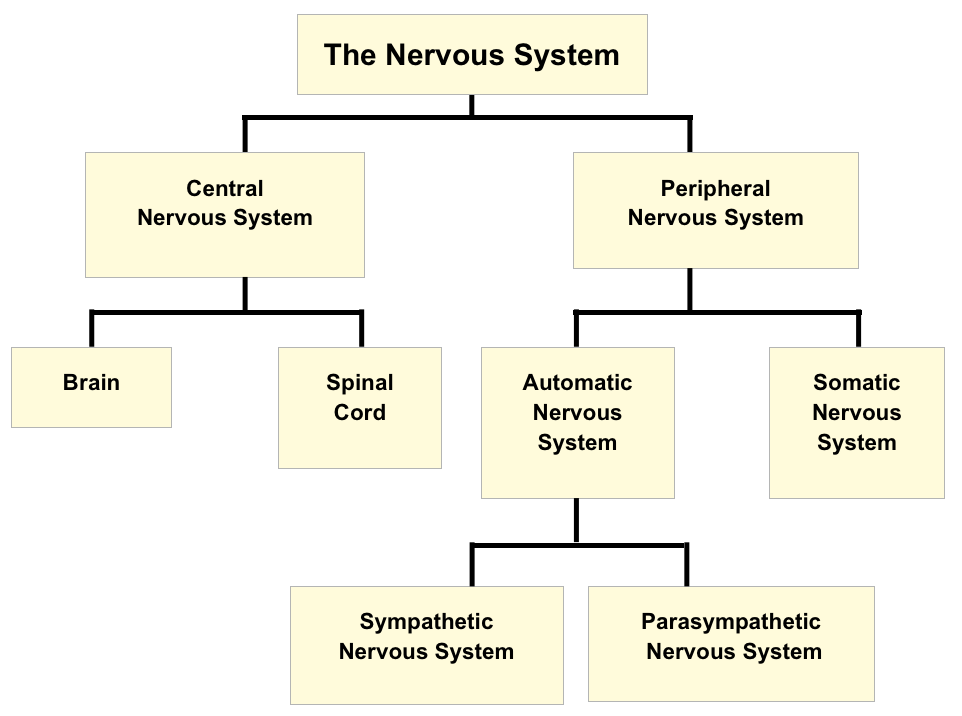
What constitutes the central nervous system? How are the components of the central nervous system protected? What are the constituents of the peripheral nervous systems?
Answer
584.4k+ views
Hint: Nervous system coordinates and controls the activities of the animals. Together, with the endocrine system, the nervous system maintains the homeostasis.
Complete answer:

Fig: Schematic diagram showing constituents of Nervous system
The nervous system is broadly classified as:
-Central nervous system (CNS): Formed by the brain and the spinal cord.
-Peripheral nervous system (PNS): Involves nerve fibres that carry information between the CNS and the periphery (other parts of the body). It involves cranial nerves, spinal nerves and their branches, ganglia, and sensory receptors.
The PNS is further classified into afferent and efferent divisions. The afferent division includes afferent nerve fibres that carry information from tissues and organs to the CNS. Instructions from the CNS are transmitted through efferent nerve fibres of the efferent division to effector organs (muscles or glands) that carry out the orders to bring about the desired effect.
The efferent division is classified into the somatic nervous system and autonomic nervous system.The somatic nervous system consists of the nerve fibres that transmit impulses from the CNS to skeletal muscles and comprise a voluntary branch of the peripheral efferent division. The autonomic nervous system consists of the nerve fibres that transmit impulses from the CNS to the smooth muscles, cardiac muscles, and glands of the body and comprise the involuntary branch of the peripheral efferent division. The sympathetic nervous system and the parasympathetic nervous system are the branches of the autonomic nervous system.
CNS is enclosed by hard, bony structures. The brain is encompassed by cranium (skull)), and the vertebral column surrounds the spinal cord. Inside the skull and the vertebral column, three protective connective tissue coverings, the meninges, lie between the bony covering and the nervous system. The brain is covered by cranial meninges. From outer to inside, dura mater, avascular arachnoid mater, and pia mater.
The spinal cord is covered by spinal meninges. They are continuous with cranial meninges. The structure is exactly similar to cranial meninges except the cranial dura mater has two layers but the spinal dura mater has one layer.
Note: In addition to the CNS and PNS, there is an extensive network of nerves in the wall of the digestive tract which forms the enteric nervous system controlling digestive functions. It acts independently.
Complete answer:

Fig: Schematic diagram showing constituents of Nervous system
The nervous system is broadly classified as:
-Central nervous system (CNS): Formed by the brain and the spinal cord.
-Peripheral nervous system (PNS): Involves nerve fibres that carry information between the CNS and the periphery (other parts of the body). It involves cranial nerves, spinal nerves and their branches, ganglia, and sensory receptors.
The PNS is further classified into afferent and efferent divisions. The afferent division includes afferent nerve fibres that carry information from tissues and organs to the CNS. Instructions from the CNS are transmitted through efferent nerve fibres of the efferent division to effector organs (muscles or glands) that carry out the orders to bring about the desired effect.
The efferent division is classified into the somatic nervous system and autonomic nervous system.The somatic nervous system consists of the nerve fibres that transmit impulses from the CNS to skeletal muscles and comprise a voluntary branch of the peripheral efferent division. The autonomic nervous system consists of the nerve fibres that transmit impulses from the CNS to the smooth muscles, cardiac muscles, and glands of the body and comprise the involuntary branch of the peripheral efferent division. The sympathetic nervous system and the parasympathetic nervous system are the branches of the autonomic nervous system.
CNS is enclosed by hard, bony structures. The brain is encompassed by cranium (skull)), and the vertebral column surrounds the spinal cord. Inside the skull and the vertebral column, three protective connective tissue coverings, the meninges, lie between the bony covering and the nervous system. The brain is covered by cranial meninges. From outer to inside, dura mater, avascular arachnoid mater, and pia mater.
The spinal cord is covered by spinal meninges. They are continuous with cranial meninges. The structure is exactly similar to cranial meninges except the cranial dura mater has two layers but the spinal dura mater has one layer.
Note: In addition to the CNS and PNS, there is an extensive network of nerves in the wall of the digestive tract which forms the enteric nervous system controlling digestive functions. It acts independently.
Recently Updated Pages
Two men on either side of the cliff 90m height observe class 10 maths CBSE

What happens to glucose which enters nephron along class 10 biology CBSE

Cutting of the Chinese melon means A The business and class 10 social science CBSE

Write a dialogue with at least ten utterances between class 10 english CBSE

Show an aquatic food chain using the following organisms class 10 biology CBSE

A circle is inscribed in an equilateral triangle and class 10 maths CBSE

Trending doubts
The shortest day of the year in India

Why is there a time difference of about 5 hours between class 10 social science CBSE

Write a letter to the principal requesting him to grant class 10 english CBSE

What is the median of the first 10 natural numbers class 10 maths CBSE

The Equation xxx + 2 is Satisfied when x is Equal to Class 10 Maths

What is the missing number in the sequence 259142027 class 10 maths CBSE




